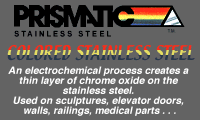
Curated with aloha by
Ted Mooney, P.E. RET

The authoritative public forum
for Metal Finishing 1989-2025

-----
Chromic acid anodizing, black oxiding of indium
1998
1. AMS2470 does not require analysis of aluminum in chromic acid anodize solutions. Should we check for this anyway? Our coating weights are going down, and we don't know why. Any suggestions?
2. We have a requirement to plate .0001-.0002 Indium over silver, diffuse at 290 F, then black oxide all over. Suddenly the plated surfaces are coming out of the black oxide smutty and brown. Any thoughts?
Thank you.
Pat
aircraft engines - Indianapolis, Indiana
1998
Patricia:
You must have a high aluminum content in the chromic acid tank. Even if the spec does not call for checking aluminum, it should be done anyway. How long have you been doing chromic acid anodizing? We have ways of removing the aluminum from the chromic acid bath, but it is a very long explanation and expensive to set up. We use an Ion-exchange system to remove the chrome from the rinse tanks and put it back into the process tank. This worked great until we found that we were building up aluminum in the chromic acid tank at a faster rate than before. We had to devise a method to remove aluminum from the process bath, which we have done. The only other alternative is to haul the bath to an off site facility for destruction or reclamation which is costly.
Regards,
Bob
B&M Finishers / Prismatic Stainless Steel
Kenilworth, New Jersey

1998
The presence of aluminum in the chromic acid reduces the conductivity and anodizing efficiency, which are bad in chromic acid solution anyway. Both aluminum and trivalent chrome must be controlled, and titration procedures are relatively simple. Ion exchange is probably cheaper in the long run than dumping, treating and disposing of the spent acid.
I recommend that you restate your plating question in the plating section of this site. Some of us anodizers know a little about plating, but I believe precious metal plating is out of most anodizers' realm.

Phil Johnson
- Madison Heights, Michigan
A porous pot will control trivalent and remove copper, possibly aluminum. The cheapest practical unit is available from Hard Chrome Consultants in Cleveland.
By the time you consider the waste treatment costs of the effluent of the regeneration if the ion exchange, you will probably be as cheap to use the dump method or the bleed & feed method.
You can concentrate it by evaporation and significantly reduce the disposal cost. Option 2 is to ad sulfuric acid and plate the chrome out to a lower concentration which can then be boiled down and put back into the plating tank for further reduction.
Check with your EPA first. Some have taken a stupid interpretation that it is not allowed. It is allowed! Just the same as any other waste PRE treatment is allowed by a letter of clarification to the CFR issued by the USEPA over 10 years ago. They never bothered to include it or amend the CFR.
The exhaust system for the plating operation could be tied into your existing system for the anodizing and probably avoid the cost of a new system and having it approved and tested. Think tall and skinny on your tank to hold down the required exhaust, 250 cu ft per sq ft of tank area. Wings on the side of the tank really help control the capture of the mist.
As stated above, you must control your aluminum content which can be done by baumé/specific gravity if you are doing a hex/trivalent analysis. AA is the real way to go, but that is several thousand dollars for a used unit.
James Watts- Navarre, Florida
1998
Q, A, or Comment on THIS thread -or- Start a NEW Thread